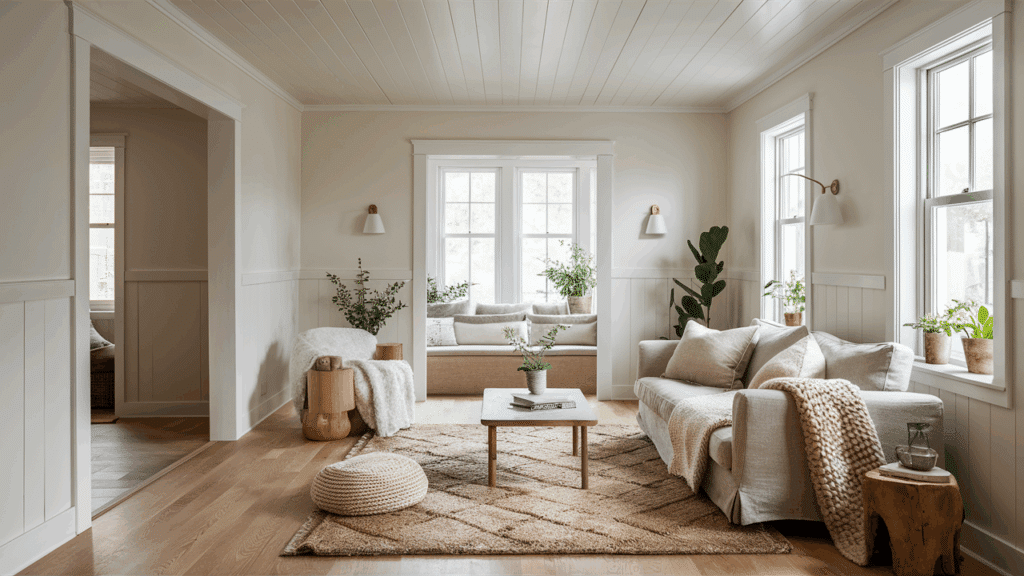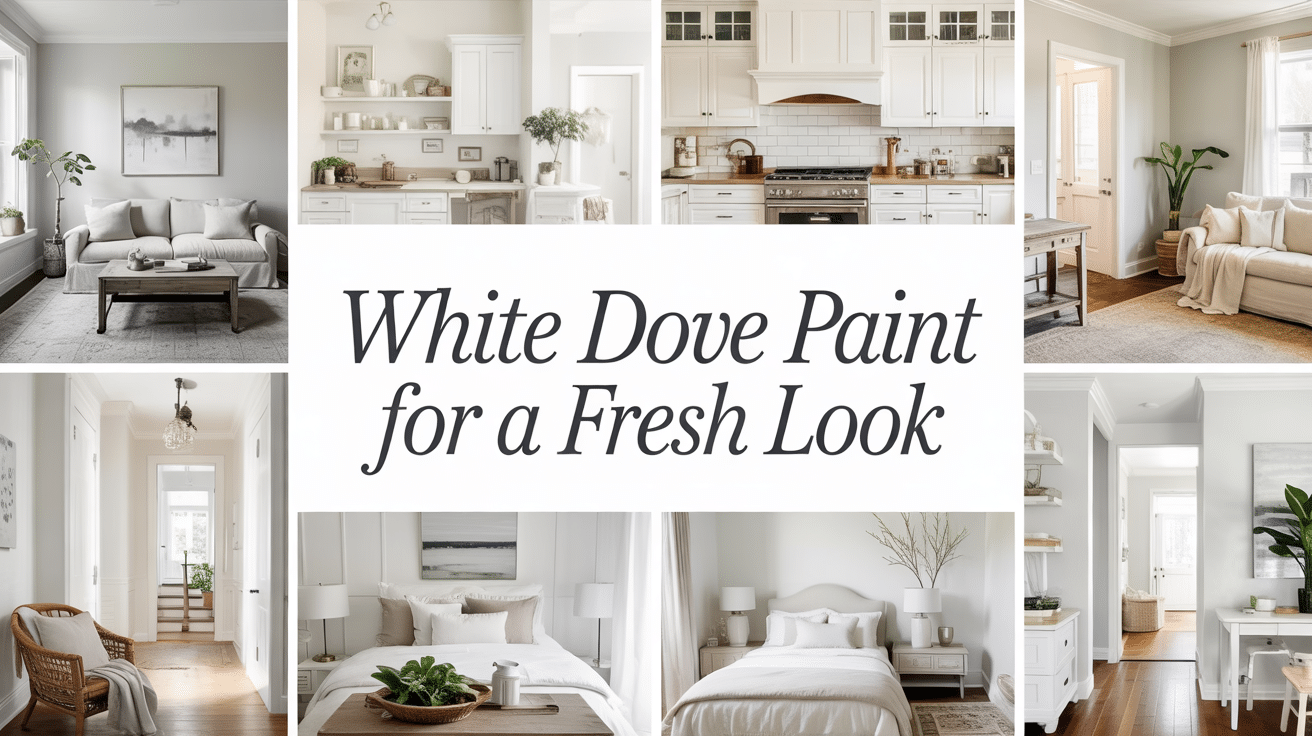Tired of staring at dull walls? White Dove might be the answer you’re looking for.
In this guide, I’ll explain everything you need to know about using White Dove paint to transform your space. You’ll learn why this shade is so popular, how to prep your surfaces properly, and the best techniques for application.
I’ve been painting homes and have used White Dove in countless projects. It’s consistently one of my top recommendations for clients wanting a clean, bright look without harsh intensity.
Whether you’re refreshing a bedroom, brightening a kitchen, or updating your entire home, this article will help you:
- Choose the right finish for each room
- Prepare your surfaces correctly
- Apply the paint like a pro
- Maintain your beautiful new walls
Let’s get started on creating that fresh, timeless look you’ve been dreaming about.
What Color is White Dove, Really?

White Dove isn’t just plain white. It’s more interesting than that.
I’ve used White Dove paint in dozens of homes, and here’s what I can tell you: it’s an off-white with subtle undertones that make it special.
So what does it actually look like?
White Dove has a soft, warm base with very light gray and beige undertones. This combination creates a color that feels clean without being stark or clinical.
Think of it as a white with personality.
When you put White Dove on your walls, you’ll notice it changes throughout the day. In morning light, it might look brighter and more crisp. By evening, it often takes on a warmer, cozier feel.
The magic of the White Dove comes from its versatility:
- It works in both modern and traditional spaces
- It pairs well with almost any accent color
- It makes rooms feel larger and more open
- It doesn’t turn yellow over time like some whites
Why does this matter to you? Because choosing the right white can be tricky. White Dove strikes that perfect balance — not too warm, not too cool, and never harsh on the eyes.
Where to Use White Dove Paint in Your Home
- Living Room: Brightens without feeling cold
- Kitchen: Perfect for cabinets or walls
- Bedrooms: Calm, cozy, and clean
- Bathrooms: Makes small spaces feel larger
- Trim & Ceilings: Great pairing with walls for a seamless look
White Dove is incredibly versatile, which is why I recommend it so often to my clients. Let me walk you through each space where this paint color really shines.
In your living room, White Dove creates an inviting backdrop that feels bright without the harshness of pure white. It provides the perfect canvas for your furniture and decor to stand out. The subtle warmth makes the space feel welcoming rather than sterile.
For your kitchen, you can’t go wrong with White Dove on the cabinets or walls. It keeps the heart of your home clean and fresh. On cabinets especially, it offers a timeless look that won’t feel dated in a few years.
In bedrooms, this color creates a peaceful retreat. The soft quality of White Dove helps create a sense of calm while still keeping the space feeling clean and open. It works beautifully with any bedding colors or styles.
White Dove’s light-reflecting properties greatly benefit bathrooms. Even the smallest powder room will feel more spacious and airy. It also complements most tile and fixture finishes.
Finally, White Dove is excellent for trim and ceilings. Using it throughout your home creates a cohesive flow from room to room. When used on both walls and trim, it makes a subtle, sophisticated monochromatic look that designers love.
Best Color Pairings with White Dove
- Other neutrals: Edgecomb Gray, Revere Pewter, Simply White
- Bold accents: Navy, black, forest green
- Wood tones: Light oak, walnut, weathered wood
- Tip: Include soft textures and natural elements for balance
Finding the right colors to pair with White Dove can take your space from nice to stunning. I’ve experimented with countless combinations over the years, and these are my top recommendations.
White Dove plays exceptionally well with other neutrals. Edgecomb Gray adds a soft, warmer contrast that feels natural alongside White Dove. Revere Pewter provides a bit more depth without overwhelming the space. Simply White works beautifully for trim when you want a subtle distinction between walls and woodwork.
If you’re looking to make a statement, try bold accent colors. Navy creates a classic, timeless contrast that feels sophisticated rather than jarring. Black details add definition and drama. Forest green introduces a natural element that feels both current and timeless.
Wood tones are White Dove’s best friends. Light oak keeps spaces feeling bright and airy. Walnut adds warmth and richness that balances White Dove’s crispness. Weathered wood brings texture and character to the clean backdrop.
One thing I always tell my clients is to incorporate plenty of soft textures and natural elements when using White Dove. This prevents the space from feeling too stark or one-dimensional. Think woven baskets, plush throws, indoor plants, or natural stone surfaces.
White Dove for Walls, Trim, or Cabinets?
- Why it works on all three
- Tips for using different sheens (matte for walls, semi-gloss for trim, satin for cabinets)
- How to create a tone-on-tone look for a soft, clean vibe
White Dove is incredibly versatile. That’s why I love using it throughout entire homes, not just on a single surface.
Let me break down why it works so well on different surfaces and how you can use it effectively:
On walls, White Dove creates a soft, warm backdrop that makes rooms feel open and inviting. The subtle undertones prevent it from looking stark or clinical. I typically recommend a matte or eggshell finish for walls – matte hides imperfections better, while eggshell offers a bit more durability for cleaning.
For trim and moldings, White Dove delivers a clean, crisp look that defines architectural details without harsh contrast. Use a semi-gloss finish here – it stands up to scuffs, highlights the details, and creates just enough distinction from your walls even when using the same color.
Cabinets painted in White Dove look fresh and timeless. The color’s warmth prevents your kitchen from feeling sterile. A satin or pearl finish works best for cabinets – durable enough for frequent cleaning but not so shiny that it shows every fingerprint.
To create a tone-on-tone look that feels cohesive and sophisticated, use White Dove on both walls and trim, but vary the sheen. This subtle contrast adds depth without breaking up your space. For an even softer look, pair White Dove walls with Simply White trim; they’re close cousins with just enough difference to create gentle definition.
When painting cabinets, I always remind clients that proper preparation is crucial. Sand thoroughly, use a good primer, and apply at least two coats for a finish that will last for years.
White Dove in Different Lighting
- How it changes in natural light vs artificial light
- Best rooms for morning or evening light
- Quick tip: Always test a sample first!
Designer Tips for a Fresh Cozy Look with White Dove
- Add contrast with dark hardware or bold fabrics
- Layer in texture: linens, woven baskets, warm woods
- Please keep it simple for a timeless feel
White Dove creates a beautiful canvas, but the magic happens when you add the right elements to bring the space to life. Over the years, I’ve learned some key designer tricks that transform White Dove rooms from simply nice to truly special.
1. Contrast Is Your Friend
White doves’ soft nature means it responds beautifully to darker elements. Try matte black hardware on kitchen cabinets or bathroom vanities.
In living spaces, introduce navy or charcoal throw pillows against a White Dove backdrop. These darker accents create focal points that draw the eye and add depth to the room.
2. Texture Is Essential
With any white paint, but especially important with White Dove. Without it, rooms can feel flat despite the color’s inherent warmth. I recommend layering in natural linen curtains, chunky knit throws, seagrass or jute rugs, and woven baskets. These elements add visual interest and tactile comfort that makes White Dove spaces feel lived-in rather than sterile.
3. Wood Tones Warm Things Up
Tremendously. White Dove has a particular affinity for natural wood elements – from furniture to cutting boards to exposed beams. The contrast between the crisp paint and organic wood creates a balanced, inviting atmosphere that feels both fresh and grounded.
4. Keep Your Overall Design Relatively Simple
One benefit of White Dove is its timeless quality – it doesn’t feel trendy or dated. To maintain this timeless appeal, avoid overcrowding the space with too many decorative items. A few well-chosen pieces will have more impact than numerous small accessories.
Remember that lighting dramatically affects how White Dove appears. Consider adding warm-toned bulbs in key fixtures to enhance its cozy qualities, especially in spaces where you entertain or relax in the evening.
Conclusion
White Dove paint offers the perfect solution for anyone looking to refresh their home with a versatile, timeless color. Whether you’re painting walls, trim, cabinets, or all three, this warm off-white creates spaces that feel both clean and welcoming.
By pairing it with the right colors, varying your finishes, and adding thoughtful textures and contrasts, you can create a look that’s distinctly yours while maintaining the fresh, open feeling that makes White Dove so popular.
Remember that proper preparation and application are key to achieving professional-looking results. With the tips and techniques shared in this guide, you’re well-equipped to transform any room in your home into a bright, beautiful space that will look fantastic for years to come.

